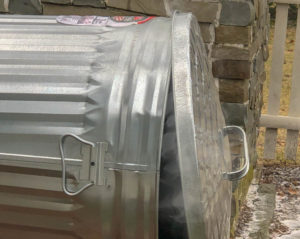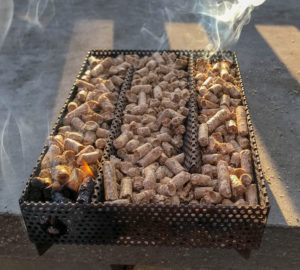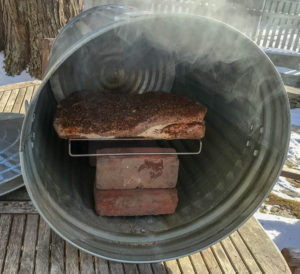
My first try at cold smoking a fish used an ordinary mailbox. It was just the right size for a salmon, but the fish got too hot, and turned into salmon jelly. It was OK, though – I just baked it a bit more in a regular oven, turning it into hot-smoked fish instead. Eventually, I turned the mailbox smoker into a hole for a miniature golf course that we made as part of a competition at work. Everyone loved it as a golf hole – my team won the prize that year – but a lot of people did ask why it smelled so smoky.
Eaters, as I read through the lines above, the first ones I am writing as part of this new blog, I am pretty sure a lot of you are going to think that I am full of shit. That may never change. But I swear on my honor that I took an ordinary USPO-approved mailbox, hooked up some 4” dryer vent to the back underside, ran the venting to a cheap aluminum saucepan sitting on a Kmart hot plate, filled the saucepan half-full of soaked wood chips, and expected it to work. Which it almost did.
I can’t believe I didn’t take any pictures. It was impossible to look at without smiling. Everyone asked, “Are you going to raise the little red flag when the fish is done?” But then, as now, I was much more interested in eating the results than in keeping a photographic record. And of course, it wasn’t exactly a culinary success. My goal was not to make salmon jell-o, though right now that sounds like it could be kind of hip. Almost molecular.
The thing is, I was too ignorant at the time to absorb the obvious: summer is not the time to cold-smoke fish. Once salmon gets much over 80 degrees, it no longer wants to be lox. It wants to go all postmodern. Also, I didn’t know I was waiting for the invention of that idiot savant of smoking devices, the A-Maze-N Smoker. This fabulous device is what enabled me to make lox in a trash can.

As you can see, the A-Maze-N smoker itself is pig simple. You just pack the channels with hardwood pellets (fruitier woods like cherry or apple are nice with fish; traditional woods like oak are better with pastrami), light it up through the little holes in the corners with a propane torch, and huzzah! This humble little thing (about 6″ x 9″) will smoke impressively for six hours if you burn it at both ends, or twelve if you only light one corner.
If you have a contrariwise mind, you may be thinking at this point that you can just fire up the maze and stick it in your everyday barbecue grill. Well, Eater, that is not crazy. But I have been there and done that, and if you put the fish directly over the smoker, it will want to start cooking. And if you move it away from the smoldering maze, the smoke will collect in the top and then leak out the sides, leaving your salmon out of the stream. There are things you can do with tin foil and bricks, but it just isn’t pretty.
In the end, volume is your friend. Trash cans are pretty big. They can move a lot of cold air past your fish, hold plenty of product, and only heat things up to maybe 15 degrees (F) above the ambient temperature. Plus, it’s so cool to lay out an elegant spread of your own smoked salmon, and then tell everyone you did it in a garbage can.
We might consider some alternatives. For example, I have often maintained that you could smoke fish in a large cardboard box. However, Poppa Larry does not personally recommend that you set a fire inside of a paper carton in your backyard. But I will give you all my pro tips for working with the A-Maze-N smoker and an ordinary galvanized trash can.


- Lighting up the pellets with an ordinary propane torch is easy-peasy, but you have to keep the flame going until they can burn all by themselves for at least a couple of minutes. Blow the flame out when you’re ready to smoke.
- I’ll smoke fish at any outdoor temperature from a little below freezing to a cool summer night in the low 60’s (F).
- Lay your trash can horizontally and stabilize it with a couple of bricks. Put a couple more bricks in the back of the can, and lay the smoker on that. Don’t set the smoker directly on the galvanized metal.
- Put your smokeables on an open grill elevated with another couple of bricks stood on their ends, so your food sits in the smoke stream.
- Before I actually started my smoking career, I dreamed up all kinds of MacGyvery ways to adjust the ventilation. Now I just hook the trash can cover over the upper lip, as shown above, leaving it open a couple of inches at the bottom, and let it sit there.
A note about food safety: trash can cooking has a long and glorious history, especially when it comes to roasting turkey, but galvanized metal is not something you want to poke with too hot a stick. Our friends at the American Galvanizers Association declare that zinc destruction starts at around 400 degrees, which is why I set the smoker on bricks. All the same, I’ve cooked any number of washtub clambakes over an open flame, and I noticed the other day that my toaster oven has a galvanized interior, and a thermostat that goes up to 500.
Anyway. I have decided not to worry about excess zinc in either my lox, or my toasted bagel. But I do have a confession to make. In my own backyard, I have a lovely outdoor bread/pizza oven that makes a very fine smoker. My wife would prefer I use that, but the thing is, when I smoke in the oven, I feel like a suburbanite. When I smoke in the trash can, I feel like a hobo pioneer.
Not everyone will want to cook in a trash can. Not that it’s edgy. In fact it’s the exact opposite; it’s blunty. Which I now realize is one of my food aspirations: blunt hobo pioneer cuisine. If you’re ready to hop on that bandwagon, a lovely and durable $25 trash can is as close as your local refuse materials merchant. So get hooked up, check out some of the cold-cured recipes, and join me in the creation of this exciting old/new avenue of food preservation. Or you could always find a nice big cardboard box.
